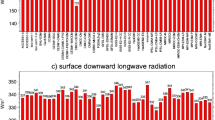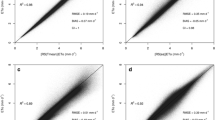Summary
A number of studies have sought to relate net radiation over natural surfaces to incoming global radiation. Several deficiencies are noted in interpretation of the simple regression models used for this purpose in the past. A modification proposed for correction of these deficiencies introduces a new longwave exchange coefficient, λ, that relates the change in net longwave radiation to the change in net shortwave radiation. This coefficient is a conceptual improvement of β, the surface heating coefficient that has gained some acceptance.
The definition of a unique λ for various surfaces is shown to be the same problem faced by past studies that have sought to develop a unique regression equation over each surface. The coefficient λ may serve as an index of the surface properties that govern the dissipation of absorbed global radiation. We recognize that this index is also affected by environmental characteristics. Interpretation of the index is demonstrated for three types of surfaces under cloudless skies: a desert, a forest, and an irrigated crop. Further consideration of the coefficient λ reveals that the apparent success of regression relations linking net and global radiation may often be attributed to negligible variation of longwave exchange rather than to the soundness of a particular regression model.
Zusammenfassung
In einer Anzahl von Studien wurde versucht, die Strahlungsbilanz über natürlichen Oberflächen mit der einfallenden Globalstrahlung zu korrelieren. Die einfachen Regressionsmodelle, die bisher zu diesem Zwecke verwendet wurden, weisen etliche Mängel auf. Um diese Mängel zu beheben, wird ein langwelliger Austauschkoeffizient λ eingeführt, der die Änderung in der langwelligen Strahlungsbilanz mit den Änderungen in der kurzwelligen Bilanz in Zusammenhang bringt. Dieser Koeffizient weist gegenüber dem Bodenerwärmungskoeffizienten β, der desöfteren angewendet wurde, einige Verbesserungen auf.
Die Definition eines eindeutigen Wertes λ für verschiedene Oberflächen besitzt die selben Schwierigkeiten wie die Entwicklung einer eindeutigen Regressionsgleichung für eine bestimmte Oberfläche. Der Koeffizient λ mag als Index der Oberflächeneigenschaften dienen, welche die Dissipation der absorbierten Globalstrahlung bestimmen. Dieser Index wird unter anderem von Charakteristika der Umgebung beeinflußt. Eine Interpretation des Indexes wird anhand von drei verschiedenen Arten von Oberflächen unter wolkenlosen Bedingungen vorgeführt: Wüste, Wald und bewässertes Baumwollfeld. Eine weitere Betrachtung des Koeffizienten λ zeigt, daß der offensichtliche Erfolg von Regressionsgleichungen zwischen Strahlungsbilanz und Globalstrahlung oft auf die vernachlässigbaren Änderungen in der langwelligen Bilanz zurückgeführt werden kann und nicht unbedingt auf die Richtigkeit des angewandten Regressionsmodelles.
Similar content being viewed by others
References
Aizenshtat, B. A.: The Heat Balance and Microclimate of Certain Landscapes in a Sandy Desert. U. S. Weather Bureau, Wash. D. C., pp. 67–130. Translation (1960).
Berger-Landefeldt, U.: Über den Strahlungshaushalt verschiedener Pflanzenbestände. Ber. Deut. Botan. Ges.77, 27–48 (1964).
Davies, J. A.: A Note on the Relationship between Net Radiation and Solar Radiation. Quart. J. Roy. Meteor. Soc.92, 109–115 (1967).
Davies, J. A., andP. H. Buttimor: Reflection Coefficients, Heating Coefficients and Net Radiation at Simcoe, Southern Ontario. Ag. Meteor.6, 373–386 (1969).
Ekern, P. C.: The Fraction of Sunlight Retained as Net Radiation in Hawaii. J. Geophys. Res.70, 785–793 (1965).
Fritschen, L. J.: Net and Solar Radiation over Field Crops. Ag. Meteor.4, 55–62 (1967).
Galoux, A., andJ. Grulois: Recherches sur l'écosysteme forêt, La chênaie mélangee calcicole de Virelles-Blaimont. Exchanges radiatifs et convectifs en phase vernale. Trav. Stat. Rech. Eaux et Forêts, A,13, 1–52 (1968).
Gay, L. W.: Comments on ‘Spatial Variation of Net Radiation, Albedo and Surface Temperature of Forests’. J. Appl. Meteor.8, 701–702 (1969).
Idso, S. B.: An Analysis of the Heating Coefficient Concept. J. Appl. Meteor.7, 716–717 (1968).
Idso, S. B., D. G. Baker, andB. L. Blad: Relations of Radiation Fluxes over Natural Surfaces. Quart. J. Roy. Meteor. Soc.95, 244–257 (1969).
Impens, I., andR. Lemeur: The Radiation Balance of Several Field Crops. Arch. Met. Geoph. Biokl., B,17, 261–268 (1969).
Monteith, J. L., andG. Szeicz: The Radiation Balance of Bare Soil and Vegetation. Quart. J. Roy. Meteor. Soc.87, 159–170 (1961).
Monteith, J. L., andG. Szeicz: Radiative Temperature in the Heat Balance of Natural Surfaces. Quart. J. Roy. Meteor. Soc.88, 496–507 (1962).
Rijks, D. A.: Water Use by Irrigated Cotton in Sudan. II. Net Radiation and Soil Heat Flux. J. Appl. Ecology5, 685–706 (1968).
Shaw, R. H.: A Comparison of Solar Radiation and Net Radiation. Bull. Amer. Meteor. Soc.37, 205–206 (1956).
Stanhill, G., G. J. Hofstede, andJ. D. Kalma: Radiation Balance of Natural and Agricultural Vegetation. Quart. J. Roy. Meteor. Soc.92, 128–140 (1966).
Stanhill, G., J. T. H. Cox, andS. Moreshet: The Effect of Crop and Climatic Factors on the Radiation Balance of an Irrigated Maize Crop. J. Appl. Ecology5, 707–720 (1968).
Stanhill, G., andM. Fuchs: The Climate of the Cotton Crop: Physical Characteristics and Microclimate Relationships. Ag. Meteor.5, 183–202 (1968).
World Meteorological Organization: Guide to Meteorological Instrument and Observing Practices, WMO-8, TP.3, 3rd ed. Geneva (1969).
Author information
Authors and Affiliations
Additional information
With 3 Figures
Rights and permissions
About this article
Cite this article
Gay, L.W. The regression of net radiation upon solar radiation. Arch. Met. Geoph. Biokl. B. 19, 1–14 (1971). https://doi.org/10.1007/BF02243399
Received:
Issue Date:
DOI: https://doi.org/10.1007/BF02243399




